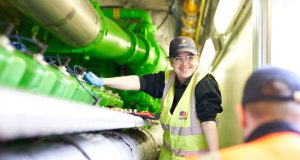 THE FUEL SUPPLIER’S VIEW
THE FUEL SUPPLIER’S VIEW
MARK ANDREWS,
DIRECTOR, CROWN OIL
In recent years, climate change has indeed had an impact on global weather patterns. We saw the impact the ‘Beast from the East’ had on the UK last year, and 2019 was officially the hottest June on record, according to the European Centre for Medium-Range Weather Forecasts. More erratic weather patterns can only be expected, and a reduction in carbon emissions is a sure-fire way to mitigate this. Facility managers will have a key voice in helping businesses to achieve net-zero carbon emissions.
Two key points for FMs to examine are: fuel supply; and their power and heating systems. Many commercial premises use gas oil (red diesel) for heating, but there are several ways to help achieve net zero carbon emissions.
One can expect regulations regarding CO2 emissions to toughen in the run-up to 2050. Achieving carbon neutrality will not just be an environmentally-conscious decision, but essential practice for businesses. Although the UK industry relies heavily on fuel – with as much as 7.80 million tonnes of gas oil consumed in the UK in 2017, there are a number of carbon neutral options that don’t require investing in new heat and power generating systems.
Going forward, two key fuels that we expect to see an increase in prominence and that FMs will see value in, are Hydrogenated vegetable oil (HVO) biofuel and carbon offset red diesel (CORD fuel).
HVO biofuel is a carbon neutral biofuel that is increasing in popularity as businesses learn the importance of being carbon neutral and its benefits over other biofuels.
HVO is produced by a separate process to normal biodiesel, mainly being that while biodiesel uses methanol as a catalyst in the esterification process, HVO uses hydrogen. Using hydrogen leads to a hydrogenation process instead of esterification, which removes any oxygen from the fuel, which increases its shelf life as the risk of contamination is reduced significantly. This makes HVO a more clean-burning, environmentally-friendly alternative, without the short shelf life of regular biodiesel. Another benefit is that its chemical structure is almost identical to regular diesel, meaning it can be used immediately, without modification of engines, machinery or generators.
A separate workaround is CORD fuel. This is red diesel but its carbon emissions are offset via an external party through investments in projects to remove CO2 from the atmosphere – these can include tree-planting to green energy generation in various locations. Offsetting is recognised by the UK Government as a method of reducing emissions and if you have a heavy reliance on gas oil, carbon offset red diesel is an attractive proposition as it requires no change to any infrastructure.
Outside of fuel, heating systems are a huge source of energy loss, with research by the Carbon Trust suggesting that around 75 per cent of energy consumed by premises is lost to their surroundings. FMs must ensure their heating systems are well maintained to avoid excess CO2 being emitted unnecessarily.
Two key aspects to look at are to ensure your facility’s boiler and fuel storage tank is clean. The fuel industry recommends an annual Non-Destructive Test of your system to check for sediment build-up in your system and your fuel. If treatable, any sediment found can be cleaned through fuel polishing.
Lastly, to ensure radiators are bled annually to remove any air build-up that may inhibit optimal spread of heat in the radiator. Maintenance like this is basic, however it allows your heating system to run efficiently and avoid unnecessary burning of valuable fuel.
While new fuels on the market are making it possible for commercial fuel users to achieve carbon neutral, carbon emissions must also be reduced by limiting waste.
 THE TECHNOLOGY EXPERT’S VIEW
THE TECHNOLOGY EXPERT’S VIEW
GARY WATKINS,
GROUP CEO – SERVICE WORKS GLOBAL
As custodians for the workplace, the challenge for FMs is significant: reduce energy consumption while maintaining high levels of service provision and workplace productivity. While a zero emissions target is daunting, there will be monetary benefits for the business as reductions are made; a 20 per cent cut in energy costs represents the same bottom line benefit as a five per cent increase in sales for many businesses. There are quick wins to be had in this respect, but they are being missed due to lack of understanding of where energy is used and wasted.
Seventy seven per cent of FMs are now using CAFM (Computer Aided Facilities Management) software, according to research by Service Works Global, and this powerful technology is providing the ability to control and understand buildings and assets like never before.
Combined with smart technology, CAFM gives an unprecedented level of data and automation, essential in this fight against waste. Sensors placed around buildings can detect occupation and identify activity patterns, allowing lighting, air conditioning or even cleaning to specific areas to be reduced. Using more widespread applications, CAFM can be integrated with BMS (Building Management Systems) and a room booking system, enabling meeting rooms and offices to be powered only when in use.
Keeping mechanical assets running at peak performance reduces energy usage, although this is sometimes overlooked due to the time-consuming nature of calculating optimum maintenance scheduling. A CAFM system can do this easily, reducing unnecessary servicing and unscheduled call outs. It can also monitor where most power is drawn, helping to identify where the greatest costs lie in order to inform new FM strategies.
Across large organisations, small inefficiencies can converge into substantial performance issues, damaging the environment as well as reducing productivity across the organisation. Small changes such as switching to LED lightbulbs play a substantial part in reducing energy demand, consuming 80 per cent less energy than traditional incandescent bulbs with a lifespan around ten times longer. This means less maintenance resource is required in addition to the energy savings generated. Even in the traditional ‘smallest room’, the washroom, fitting energy saving assets can make substantial cost and carbon savings. For example, paper towels and some warm air dryers can generate as much as 70 per cent more emissions than the most efficient hand dryer on the market.
FM’s expanding role in workplace strategy will also play a part in reducing emissions through the creation of more flexible working policies. Providing facilities such as bike lockups and showers delivers health benefits and a cheaper commute for employees; allowing staff to work away from the office and reducing the number of cars on the road. And, as is often cited, on average 50 per cent of office space is wasted, so moving to a more flexible working model can be the start of a space reduction or repurposing project, ultimately creating further emissions reductions.




